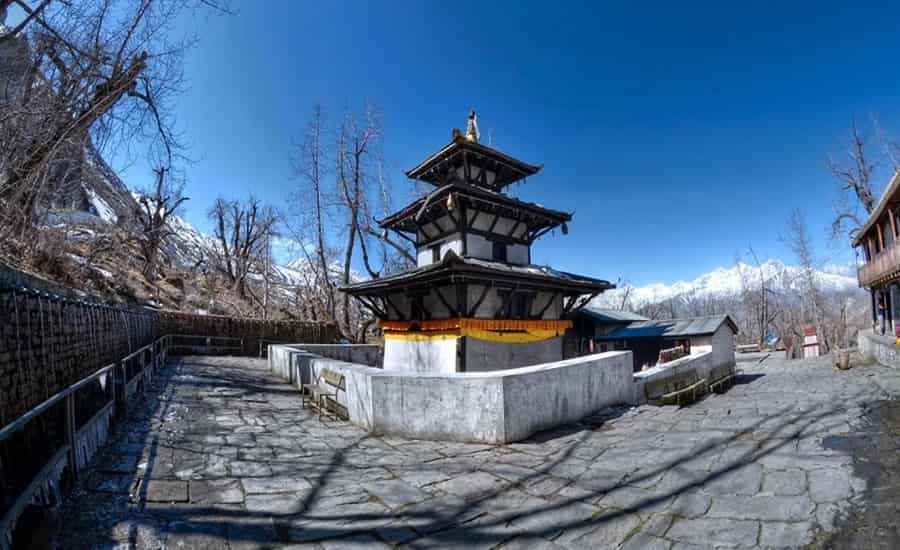Nestled in the serene Mustang Valley of Nepal, the Muktinath Temple stands as a beacon of spiritual solace and divine reverence for both Hindus and Buddhists. This sacred sanctuary, with its rich tapestry of legends, mythology, and historical significance, draws countless pilgrims seeking salvation and spiritual rejuvenation. The journey to Muktinath is arduous, traversing tough terrains and unpredictable weather, yet the spiritual fulfillment and the temple’s ethereal beauty make the pilgrimage profoundly rewarding.

Historical and Cultural Significance
Muktinath Temple, also known as Muktinath Dham, holds a venerable position in the Hindu religion. It is listed as the 106th among the 108 Divya Desams, which are the sacred abodes of Lord Vishnu, revered particularly by the Sri Vaishnava tradition. The ancient name of the temple appears in various Vaishnava texts, highlighting its longstanding significance even before it became associated with Buddhist traditions. The temple’s central feature is the Shaligram Shila, a naturally formed stone considered a manifestation of Sriman Narayan, a form of Vishnu.
Legends in Hindu Mythology
The rich tapestry of Hindu mythology envelops Muktinath with various fascinating legends:
- The Battle Between Shiva and Jalandhar: According to Hindu mythology, a pivotal battle ensued between Lord Shiva and Jalandhar, a powerful and malevolent demon king. Jalandhar, in his arrogance, attacked Kailash Parvat, Shiva’s abode, attempting to deceive Parvati by taking Shiva’s form. However, Parvati’s divine intuition saw through the ruse, and she called upon Shiva for assistance. In the ensuing battle, Lord Vishnu played a critical role by deceiving Jalandhar’s wife, Vrinda, thereby causing her to lose her devotion and enabling Shiva to defeat the demon king. In her grief, Vrinda cursed Vishnu to turn into a stone, which is believed to be the Shaligram Shila housed in the temple.
- Sati’s Sacrifice: Another legend recounts the tale of Sati, Shiva’s consort, who immolated herself after being humiliated by her father. In his sorrow, Shiva wandered the universe carrying her body. To restore cosmic order, Vishnu dismembered her body into 52 parts, each becoming a Shakti Peeth, or sacred site. Muktinath is considered one of these Shakti Peeths, where Sati’s mouth is worshipped. This association further elevates the temple’s sanctity among Hindus.
Buddhist Connections and Legends
While Muktinath is primarily a Hindu pilgrimage site, it is equally significant in Buddhist traditions. Known as Chumig Gyatsa in Tibetan, which translates to “Hundred Waters,” the temple is a revered tantric site:
- Guru Rinpoche’s Meditation: The temple is closely associated with Guru Rinpoche, also known as Padmasambhava, the founder of Tibetan Buddhism. It is believed that he meditated at Muktinath on his way to Tibet, enhancing the site’s spiritual aura. The temple is home to 21 Taras and the Dakinis, or sky dancers, who embody compassion for all Buddhas. This deepens the temple’s spiritual significance, bridging Hindu and Buddhist traditions.
- Damodar Kund: Near Muktinath lies Damodar Kund, known as Men-Chu in Tibetan. This sacred lake is the primary source of the Kali Gandaki River and the Shaligram stones, which hold religious importance in both Hindu and Buddhist cultures. The presence of these sacred waters further augments the temple’s spiritual significance.
Mukti Dhara: The Path to Salvation
The Mukti Dhara, consisting of 108 water spouts, is a defining feature of the temple. These spouts channel the cold, pure water of the Kali Gandaki River. The number 108 holds significant spiritual symbolism in Hinduism, representing the 12 zodiac signs and the 9 planets, thus encapsulating the cosmic order.
According to Hindu beliefs, bathing under these 108 bull-faced water spouts washes away sins and grants salvation (Mukti). This ritual underscores the temple’s role in providing spiritual liberation and promoting religious inclusivity.
Spiritual and Physical Journey
The pilgrimage to Muktinath is not merely a physical journey but a profound spiritual quest. Devotees traverse challenging paths and endure harsh weather conditions, driven by their faith and the promise of salvation. The temple’s location, amidst the surreal beauty of the Mustang Valley, enhances the spiritual experience. The majestic Himalayas, pristine landscapes, and the tranquil ambiance create a setting that inspires reflection and inner peace.
Cultural Harmony
Muktinath stands as a testament to religious harmony and mutual respect. It exemplifies how sacred spaces can transcend religious boundaries, uniting diverse spiritual practices. The temple’s inclusive nature, revered by both Hindus and Buddhists, fosters a sense of universal spirituality. Pilgrims from different faiths converge at Muktinath, creating a vibrant tapestry of cultural and religious diversity.
Conclusion
The history of Muktinath Dham is a captivating blend of legends, mythology, and historical significance. Its sacred ambiance and spiritual allure make it a unique pilgrimage site for both Hindus and Buddhists. The temple’s legends, from the battle between Shiva and Jalandhar to the meditations of Guru Rinpoche, enrich its spiritual narrative. The Mukti Dhara and the presence of Shaligram Shila further elevate its sanctity, offering devotees a path to salvation and inner peace. Muktinath is more than a temple; it is a spiritual haven that transcends religious boundaries, embodying the essence of divine harmony and universal spirituality.
- Suggested Tour: Muktinath Dham Yatra from Kathmandu
 Call
Call WhatsApp
WhatsApp Enquiry
Enquiry